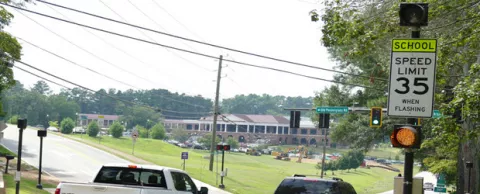
Image courtesy of Applied Information
The new school year is approaching and Georgia's Department of Transportation(GDOT) is preparing for it. GDOT is installing IoT-based smart beacon technology to enhance the reliability and responsiveness of equipment used to manage traffic in school zones. It's an indication of how mobile technology is becoming a larger part of traffic management and safety and how IoT technologies are rapidly being adapted for an increasingly broad range of applications. — Doug Peeples
The flashing signs designed to remind drivers to slow down as they travel through school zones aren't new. However, IoT and wireless connectivity are transforming them into far more than simple blinking lights.
The smart beacons GDOT is installing at more than 300 schools in 118 counties. It's said to be the first deployment of the beacons at school districts statewide. The benefit for the school districts is that the beacons are more reliable and they're smart in that they can respond to scheduling changes caused by bad weather, time changes, holidays and other events.
How do they work?
The smart beacon technology is a combination of The Glance School Zone Beacon System from intelligent transportation systems company Applied Information and wireless connectivity from Council Global Lead Partner AT&T.
The beacons have their own cellular modem for communication, a feature that allows traffic engineers use smartphones or tablets to monitor if the beacons are working properly and send alerts if a lamp or battery needs to be replaced. The beacons will run on AT&T's 4G/LTE mobile network which will also provide power for the AT&T IoT platform and its Control Center management system.
"Making school zone beacons smarter is a perfect example of how we can use connected technology to improve safety on our roadways," explained Applied Information President Bryan Mulligan. "GDOT is to be commended for taking the lead to improve safety around school zones on such a large scale and in such a short amount of time to be prepared for the new school year."
The Georgia deployment also is an example of a welcome trend, according to Mike Zeto, VP of AT&T IoT Solutions and general manager of its Smart Cities program. "Mobile technology is becoming more integrated into existing traffic equipment to help make school zones safer for school children and drivers, he said.
Doug Peeples is a Portland, Oregon-based writer specializing in technology and energy. Follow @smartccouncil on Twitter.



